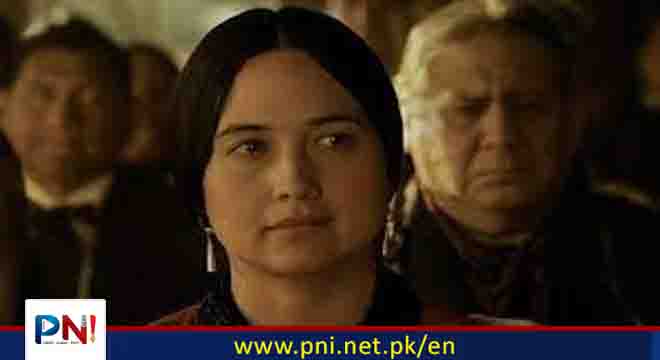Islamabad Nov 21 (Online): In an exclusive interview, Lily Gladstone talks about getting rave reviews for her portrayal of the Osage leading lady Molly in Killers of the Flower Moon.
Lily Gladstone is a revelation in Martin Scorsese’s period saga Killers of the Flower Moon. As one of the last Osage standing, Mollie, Lily exudes an easy charm. She effectively holds her own in front of stalwarts like Robert De Niro and Leonardo DiCaprio, underlining the film’s theme that Native Americans like her have so much to offer.
Lily Gladstone plays the leading lady in Martin Scorsese’s Killers of the Flower Moon
In an exclusive interview with Hindustan Times, Lily talks about her creative inputs for the film, the implied fear of getting pigeonholed as a member of her community on screen, and how the Osage is a tribe of storytellers. Excerpts:
When I interviewed Martin Scorsese last month, he said that Killers of the Flower Moon resonates with anyone who’s ever been colonised. Do you believe its story is as universal as it’s personal to you?
It’s a great question. It seems like it is universal. There are people who are resonating with it, with Mollie specifically. This film is an indictment of people’s complicity in colonisation and white supremacy because of the paradigm we look the film through. It is personal to me, but I do see that the people reacting to it the most and resonating it with the most are the ones who’ve been affected by colonisation.
You saw first-hand Martin Scorsese get acquainted with the Osage culture while making this film. Was there anything specific you personally helped him out with?
(Laughs) Yeah, and Leo too. I was visiting my language teacher, Chris Corte. Chris knows that when you teach language, you also teach culture. And if you’re teaching culture, you also teach story. Chris told me this story of a trickster figure, which we have in our nation too. Our trickster figure is different. The Osage have several trickster figures for different purposes. Chris was telling me about a coyote figure, and I kept thinking wow, it’s a really good analogy for the rest of the film. With Chris’ permission and other communities’ permissions, we used it in our film.
We don’t tell that story in the film, but Ernest (Leonardo DiCaprio) is that coyote figure. He’s soft-serving, hedonistic, loves to feel good, is kind of silly and stupid, and keeps getting into trouble. He doesn’t win in the end, but the audience learns how not to be by watching him. So I was talking to Marty how Molly had a blind spot for Ernest because she believed he wasn’t capable of that. So Molly may have seen him as this trickster figure.
When you hear these stories as a kid, they’re very funny. But then you think about them as an adult and you realise it was giving you a lesson. So Marty loved that. Leo loved that, as it gave him some kind of characterisation to sink his teeth into. It’s still kind of a joke between all of us calling Leo a coyote. When everyone was saying this film is going to be called Marty’s first Western, I jumped in and said I see it as a cautionary tale, Marty’s trickster story.
You said in an interview that no Osage filmmaker is going to get $200 million to make an epic like Martin Scorsese did.
(Laughs) I hope I’m wrong!
That’s what I’m coming to. Do you believe that you being the face of this movie is a step in the right direction, that will help us see that day sooner than we imagine?
Thank you for asking that. I hope so, I really hope so. One feedback that’s been coming in a lot is people desiring to watch more perspectives of Molly and her sisters, of what the Osage were experiencing. A lot of what was in the film was influenced by a book written by an Osage man, Charles Red Corn. It’s called A Pipe for February. Marty is very supportive of that being developed, maybe into a series. And Charles’ grandson is adapting it right now, with the support of Marty.
There are these stories that deserve this level of production and immersive worldbuilding. If it’s the trickster story that makes this film so universal, it comes from indigenous knowledge. There are Osage filmmakers who deserve that kind of budget to tell these stories through their perspective. We now know that people are excited by, challenged by, and are seeking out these stories.
Finally, do you feel the critical acclaim you’re getting from the film is going to fetch you more opportunities outside your identity as an indigenous woman? Or is there a concern that you’d be limited to roles from your community as an actor?
I’ve been asked since my undergrad if I want my characters to be limited by ethnicity. So far, it hasn’t helped me back. Any role I play, which is native or highlights native history or culture, whether or not it’s laid out, I’m always going to make that character native. Short answer: No, I’ve got some lovely offers in films that exist in different realms and are going to expand and challenge me as an actor.
Native American people have been all over the world. One example I use is that I met a Blackfeet man in Vienna. He was Viennese-born. His grandmother was a Blackfeet married to a Viennese farmer back at the turn of the century. They moved back to Vienna together and started a family. When I met him, I said yes, you look like people back home. It goes on to show that there is a narrative that we’re stuck in a narrow box, but native people have been everywhere and they’ll always be. We’re like a lot of people in the world, we’re global citizens. So any role that I play now will be an extension and demonstration of that.
Follow the PNI Facebook page for the latest news and updates.









